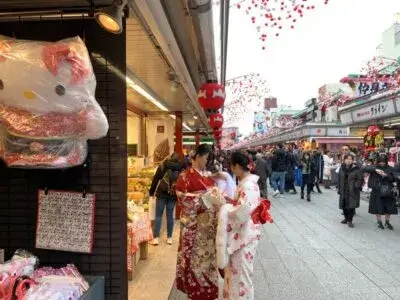In Japan, for many years the way of dressing was very different from western fashion. Until the country’s westernization in the Meiji revolution, traditional kimono were worn in daily life by everyone. The word ‘kimono’ also literally means ‘object to wear’, or clothing. Nowadays, kimono are still worn by the Japanese for certain occasions like weddings, more official ceremonies, or festivals. Let’s learn more about the way to wear a kimono properly, and about the intricate designs!

Way to Wear Kimono
The kimono generally reaches down to the ankles, although the women’s kimono is longer. This is because a lady’s kimono is tied at the hip. The neck of the kimono is attached flat and is always worn from left to right. An exception is when the person wearing the kimono has died, in this case, it is used from right to left. So be careful not to tie your kimono the wrong way! The sleeves of the garment reach the wrist and, some variations of the kimono may have sleeves that are even long enough to touch the ground.
Kimono are tied in the back with a band called ‘obi‘, knotted in to keep the kimono closed. The knot is known as a ‘musubi’. Its great versatility is based on the formality, the type of obi, and the age of the person. Kimono are generally worn with traditional footwear, known as ‘zōri’ or ‘geta’ (almost always wooden sandals). They go well with special socks called ‘tabi’ that have a parting for the slipper next to the big toe.
Design
Kimono range from extremely formal to very casual. The level of formality of a woman’s kimono is mainly determined by the pattern of the fabric and the color. Young women’s kimono have longer sleeves, which means they are not married. Their kimono also tend to be more elaborate than older women’s kimono. Men’s kimono usually have a basic concept and are mainly used in faint or darker colors.
The formality is also determined by the type and color of the accessories and the fabric. The number or absence of ‘kamon’ (family crests), is also very important, with five crests meaning extreme formality. Silk is the most desirable and most formal fabric. Kimono made of fabrics such as cotton and polyester appear more casual in style. Today, however, an ordinary person prefers to buy a kimono of these materials because it is much easier to use and care for.
From a Japanese standpoint, the kimono is a garment as formal and elegant as for a Westerner a suit or ball gown. For this reason, the kimono is generally used on important occasions like weddings, during a tea ceremony, and when visiting the ancient capital of Japan, Kyoto.
Today’s Kimono
Today, a kimono can be rented very easily in specialty stores in any large city in Japan and are accessible to the general public. It is not like many other countries where traditional clothing is seen historically but is not used in real life. In Japan, the kimono is a garment that does not go out of style throughout the years and is part of the concept of what is Japanese culture.
The kimono has a history of approximately 13 centuries, going through various changes until it became the kimono used in the current era. Therefore, for people visiting Japan, it is highly recommended to try the kimono and thus feel the Japanese culture in its most tangible form and, in passing, pay homage to the Japanese people and their history.
Kimono is one of the most appreciated garments in the world of fashion and is highly acclaimed for its elegance, beauty, and presence. Kimono was the common clothing of the Japanese until approximately the end of WW2. It is currently the de facto clothing that represents the Japanese spirit in its various variations.
Your Japan Tour
As seasoned Japan experts, we create perfect Japan package tours including a kimono wearing experience. Check out our group tours and private tours, or contact us to start planning your unforgettable holiday to this fascinating country. Japan is full of once-in-a-lifetime experiences, culture, history, nature, and delicious food!